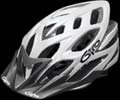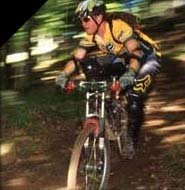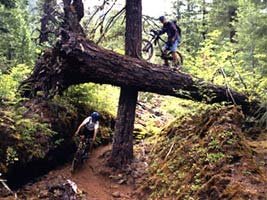Riding a mountain bike on trails and paths in foothills and mountains is a rewarding experience. Not only do you get to see some beautiful scenic views and wildlife, but you get a great workout and can get a thrill like nothing else when you travel downhill at break-neck speeds. After a challenging ride and you have racked your bike and dusted off, you'll know you're much closer to obtaining striated thighs and tris. And your cardiovascular system will thank you for it.
So how do you go about taking up the sport of mountain biking? What equipment will you need? Is there a training schedule? Where are the trails? Are there rules to follow? This article will serve as a beginner's guide to mountain biking and tell you what you need to know about taking up this challenging sport.

Equipment
A huge assortment of equipment is available these days. Knowing what you really need and what's a luxury is important - unless you're one of those fortunate people that have a never-ending supply of money.
 The Bike Itself
The Bike Itself
-
The most important piece of equipment will be, of course, your bike. If you're going to invest a lot into any equipment it should be in your bike. Purchasing a bike from a discount store under $200 may seem like a tremendous bargain at first, but one ride on the trails will quickly change your mind.
Discount-store bikes are fine for cruising around the neighborhood and riding on flat dirt paths, but they don't have the reinforced frames for bumpy mountain trails and the gearing won't hold up for your intense climbs. Quality mountain bikes are available at most local bike shops and they can help you find a bike that's suited for you.
Low-end bikes will start around $500-600. High-end bikes can cost several thousand. Here's a tip: before you purchase a bike you might want to ask a friend if you can ride their bike on a trail to see if you even like the sport first.
 |
||||
 |
|
 |
||
 |
||||
Many experienced riders have an old bike they've outgrown and they're now riding an upgraded model with more bells and whistles. (Well, maybe not whistles, but they may have bought a dual-suspension instead of a hardtail!) Try it out and then go to the bike shop and talk to them.
 Helmet
Helmet

-
Get a helmet and wear it. Chances are you won't ever need it, but the one time that you do need it, you better be wearing it.
There are many shapes and styles so find one that's comfortable and suits your fashion tastes at the same time.
 Clothing
Clothing
-
Clothing is another consideration for the sport of mountain biking.
 Biking Shorts
Biking Shorts
-
If you're spending a lot of time on the bike, you gotta have those cute little biking shorts. If you're someone who just can't stand the thought of riding around in those tight-fitting things, you're not alone.
Biking shorts do come disguised as regular hiking-type shorts. Whatever style you choose, the padding is really necessary. Plan on shelling out the money for a few pair of shorts. It's another good investment.
 Jerseys
Jerseys
-
Riding shirts - they're called jerseys - are not a necessity, but they do serve a functional purpose. They are made of a material that wicks away sweat from your body to keep you cool and the material dries quickly. Jerseys also come with several deep pockets so you can carry supplies like food, a cell phone and tools.
You won't need a jersey the first time you straddle the bike, but they are another good investment that you should consider if you plan on spending a fair amount of time on the trails. Most bodybuilders will want to purchase the sleeveless jerseys because most jerseys with sleeves are designed for guys that look like Lance Armstrong.
 Shoes
Shoes
-
Shoes especially made for mountain biking can also be purchased. They are constructed to give you foot support while in the cycling position. This keeps you from tiring as easily and will give you more pedaling power. Some shoes are designed to clip into the pedals so you become part of the bike.
Clipless pedals, as these type are called, will give you more control and better climbing power. You may want to get a feel for riding without being clipped in first because there is a learning curve to adjust getting out of these little gadgets. (That means you're gonna fall a few times getting used to them.) Regular tennies will work on your first few rides.

Training
 Tag Along To Start
Tag Along To Start
-
If you have some friends who ride, ask them if you can go along. You'll learn a lot from experienced riders and there's always safety in numbers. If you don't have that luxury and want to try it alone, find some easy trails like fire roads or gravel roads.
You won't have a lot of bumps and rocks to contend with and you'll still have fun and get a great workout. There are plenty of roads like this on the foothills of West Lancaster and in many other areas of the Antelope Valley (California).
A ride of about 30-45 minutes should be sufficient for your first few rides. Don't over do it. The more fatigued you become the greater your chances of losing your concentration. That's when a fall usually occurs.
Take it easy and gradually add to your riding time. Shoot for rides about two hours long as a goal after a couple of months. Ideally you should ride two 30-40 minute rides during the week and a longer ride on the weekend.
Rides during the week can be on the street too. Try to find a path with some hills and watch for traffic. Street riding can really help your conditioning and you don't have to worry about loose sand and bouncing over rocks.
 With Experience Try Something "Technical"
With Experience Try Something "Technical"
-
Handling your bike and getting used to avoiding rocks and ruts comes with time. As you become more experienced, try some trails that are more "technical." That means more difficult and the trail is filled with more obstacles to go around and, in some cases, go over.
 Learn how to pick a line. Look about 20 feet or so in front of you during the entire ride. As you go, determine the safest and easiest path between bumps and gulleys. Go slow at first.
Learn how to pick a line. Look about 20 feet or so in front of you during the entire ride. As you go, determine the safest and easiest path between bumps and gulleys. Go slow at first.
Learning control is the most important factor. And here's one last tip, which is based on personal experience. Whatever you do, do not - and I mean do not - hit your front brake when you're headed down a steep hill.
If you do, let's just say you had better be wearing your helmet as you kiss the ground on the other side of your handlebars.
 Spend As Much Time Riding As Possible
Spend As Much Time Riding As Possible
-
Spending time on your bike when you're out on the trails is the best way to learn, but don't forget to learn from others who know the sport. Your local bike shops are also a storage bin of biking knowledge.
The people who work there love to ride and love to share their knowledge with you. Take advantage of that. These guys and gals know where the best trails are and can give you lots of pointers.

Rules
Learning the rules of the road - I mean trail - is easy. Most of them are common sense.
- Don't litter.
- Leave the area as you found it.
- Be considerate of other bikers and hikers.
- If you encounter horseback riders give them some space and wait for them to pass. Bicyclists can spook the horses and someone could get hurt.
- If you're going around fellow bikers, give them a heads-up and say something like, "Passing on your right!" Say it loudly so they can hear you.
- Leave plants and wildlife alone. Just look at nature and enjoy it while you ride.

Mountain biking can be one of the most challenging fitness activities you'll ever do. Once you get the hang of it and your conditioning reaches levels where you no longer feel like your lungs will disintegrate on a steep climb, you'll love it.
If you're getting close to a competition, just make sure you go on some familiar trails so you'll have less of a chance of cuts and bruises. Now go hit the trails!




